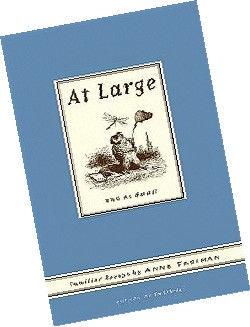Introducing: Everything you’ve ever wanted to know about Johnny Mellor — aka Woody Mellor, aka Joe Strummer (of the Clash) — who tragically passed away in 2002 due to an undiagnosed heart condition.
But talk about exhaustive biographies: Chris Salewicz’s Redemption Song: The Ballad of Joe Strummer (Farrar Straus & Giroux) takes the cake. Most music biographies fall victim to too much pre-fame, pre-relevance, and youth coverage, and Redemption Song is no different. Occasionally in the opening pages, Salewicz does flash-forward and back through Strummer’s adolescence, the Clash era, and post-death accounts from friends and relatives. For the most part, though, Redemption Song follows in chronological order, and the highlights of the first 160 pages — some of it slow reading — are as follows:
Strummer’s older brother suffered from depression and committed suicide when Strummer was 18. This had a massive impact on Strummer’s life and creative drive, including Strummer’s pre-Clash concern, the 101’ers, a decent pub rock band that never released recordings while together.
Naturally, the Clash sections of Redemption Song beat out the book’s beginning and end in terms of readability. Most interesting is the fact that the band was created by an impresario, just like the Sex Pistols, who had Malcolm McLaren. The Clash was more or less masterminded by a lesser known but equally brilliant London scenester/hustler by the name of Bernard (“Bernie”) Rhodes. The political phrases pasted on Strummer’s Telecaster, for example? That was Rhodes successfully launching a trend that carries on to this day.
Salewicz’s writing is workmanlike, and he gets the job done. It also helps that the author was a good friend of Strummer’s. This intimacy benefits Redemption Song, peppering it with minute details that a less familiar biographer might not know.

After the Clash folded, Strummer busied himself with sporadic projects, including but not limited to soundtrack work for the movie Sid and Nancy, co-writing much of the second Big Audio Dynamite (Mick Jones’ post-Clash project) album, and recording a 1989 solo album, Earthquake Weather, which turned out to be a flop.
The closing portion of Redemption Song is given over to Strummer’s final years with the Mescaleros, his handpicked band, which made a respectable impact by jumping all over the musical map: reggae, roots-rock, ska, and much cover material. It was with this group that Strummer reignited the spark that burned hot during his days with the Clash.
Clash fans are encouraged to check out Pat Gilbert’s Passion Is the Fashion: The Story of the Clash. For Strummer fanatics, see Redemption Song. — Andrew Earles
You’ve read your fair share of critical essays. You’ve read plenty of personal essays. But what of the “familiar” essay? Charles Lamb and William Hazlitt in the 1820s made the prose form famous, but over half a century ago, writer Clifton Fadiman was mourning its demise, along with what went with it: “formal manners, apt quotation, Greek and Latin, clear speech, conversation, the gentleman’s library … [and] the gentleman,” according to Fadiman’s “A Gentle Dirge for the Familiar Essay.”
But perhaps Fadiman was speaking too soon, and who better to prove him wrong than Fadiman’s own daughter — author, editor, teacher, and, yes, essayist Anne Fadiman? Her collection of a dozen essays, At Large and At Small (Farrar Straus & Giroux), makes delicious summertime reading, whether it’s Fadiman fille remembering Mr. Lamb, Samuel Taylor Coleridge, or Vilhjalmur Stefansson. You’re not familiar with Stefansson, the Arctic explorer? Fadiman would love to introduce you. The surprise ingredient to her brother’s homemade ice cream? Liquid nitrogen.

But don’t be surprised by Fadiman’s observant eye and equally keen intelligence. She was once editor of The American Scholar. She’s currently the first nonfiction writer-in-residence at Yale. But in At Large and At Small, she wears her scholarship lightly. She doesn’t indulge in Greek or Latin. Her manners aren’t exactly formal. And yet, her speech is clear; her conversational style is winning. No, she’s no gentleman. But, thanks in part to Anne Fadiman, the familiar essay is not only alive, it’s well. — Leonard Gill
Call for Submissions
It’s that time of year — time to get that short story of yours whipped into shape and into the hands of Memphis magazine, the Flyer‘s sister publication. Entries for the magazine’s annual Fiction Contest are due by mail (no faxes, no e-mails, please) on Wednesday, August 1st.
Co-sponsored this year by Burke’s Book Store and Davis-Kidd Booksellers, the contest rules are simple: Authors must live within 150 miles of Memphis; stories (which needn’t have a Memphis setting or Southern theme) should be between 3,000 and 4,500 words; and multiple entries from a single author are allowed, but each entry must come with a $10 fee. That’s a small price to pay, because the winning story earns a $1,000 grand prize and publication in a future issue of Memphis. Two honorable-mention awards of $500 each will go to stories if the quality warrants.
Need more info? Click on “Fiction Contest” at MemphisMagazine.com or contact Marilyn Sadler at sadler@memphismagazine.com. Or that’s all you need to know? Mail your short-story manuscript now to: Fiction Contest, c/o Memphis magazine, P.O. Box 1738, Memphis, TN 38101.